Stability Analysis of Surrounding Rock and Initial Support of Tunnel Undercrossing Multi-Situational Goafs: A Reference of Construction Guidance
Abstract
:1. Introduction
2. Project Profile
3. Numerical Calculation of Surrounding Rock and Initial Support Deformation Law of Tunnel Undercrossing Multi-Situational Goaf
3.1. Numerical Model and Boundary Conditions
3.2. Material Parameter Selection and Scheme Setting
4. Simulation Results and Analysis
4.1. Influence of Distance
4.2. Influence of Scale
4.3. Influence of Angle
5. Guiding Significance for Engineering
6. Conclusions
- (1)
- Since the goaf cavity is close to the left hance of the tunnel, the left arch waist of the tunnel is significantly affected by the goaf. As the distance increases, the horizontal displacement of the left arch waist continuously decreases. When the distance reaches 20 m, the horizontal displacement of the left arch waist decreases by 16% compared to when the distance is 5 m, and the vertical displacement of the vault decreases by 18%. As the distance continues to increase, both the horizontal and vertical displacements of the tunnel show a decreasing trend. The degree of collapse and subsidence of the surrounding rock at the tunnel vault becomes less severe, and the maximum axial force of the initial support shows a significant change when the distance to the goaf increases from 5 m to 10 m, decreasing by 124 KN. However, when the distance to the goaf increases from 15 m to 20 m, the change is relatively minor, with a reduction of only 70 KN. Compared to the change between 5 m and 10 m, this variation is only 56%. This indicates that once the distance increases beyond a certain point, the maximum axial force in the initial support will no longer experience significant changes.
- (2)
- As the scale of the goaf gradually increases, the deformation values at key positions of the surrounding rock continuously rise. When the diameter reaches 12.5 m, the horizontal displacement of the arch waist increases by 27.6% compared to the 5 m case, and the vertical displacement of the vault increases by 20.3%. As the scale of the goaf increases, the degree of local subsidence at the tunnel vault becomes more pronounced; the phenomenon of longitudinal arch bottom uplift becomes more evident; and the range of subsidence along the longitudinal direction is significantly enlarged. As the goaf cavity diameter changes from 5 m to 20 m, the variation in the maximum axial force of the initial support is relatively uniform and gradual, differing from the impact caused by distance.
- (3)
- As the angle gradually increases, the horizontal displacement distribution of the walls on both sides of the tunnel ceases to be symmetrical. When the angle reaches 60°, the horizontal displacement of the right arch waist increases by 18.3% compared to when the angle is 15°, while the vertical displacement decreases by 24.2%. It can be observed that with the increasing angle, the degree and extent of subsidence of the right arch waist continually increase, while the collapse degree and range of the vault decrease. As the goaf angle varies from 15° to 60°, the change in the maximum axial force of the initial support is relatively uniform. This phenomenon is similar to the effect of different goaf diameters and differs from the impact caused by distance.
- (4)
- Based on the analysis of the deformation characteristics of the surrounding rock and the stress on the initial support, to minimize the adverse effects of overlying goaf areas on the stability of the surrounding rock during tunnel construction, it is recommended in actual alignment selection that the tunnel should be positioned as far away from goaf areas as possible. If crossing a goaf area is unavoidable, the tunnel should maintain a distance from the goaf area greater than 1.13 times the tunnel span. It is also advisable to avoid crossing larger scale goaf areas and minimize the angle. During the construction process, supplementary measures such as grouting reinforcement should be considered based on the deformation characteristics of the surrounding rock and the stress behavior of the initial support under different goaf situations, as discussed in this paper. This will help reduce the possibility of significant deformation or collapse of the surrounding rock.
Author Contributions
Funding
Institutional Review Board Statement
Informed Consent Statement
Data Availability Statement
Acknowledgments
Conflicts of Interest
References
- Mabe Fogang, P.; Liu, Y.; Zhao, J.-L.; Ka, T.A.; Xu, S. Analytical Prediction of Tunnel Deformation Beneath an Inclined Plane: Complex Potential Analysis. Appl. Sci. 2023, 13, 3252. [Google Scholar] [CrossRef]
- Jia, J.X. Application of PS-INSAR Technique on Health Diagnosis of the Deformable Body on Front Slope beside Mountain Tunnel Portal. Math. Probl. Eng. 2020, 2020, 823382. [Google Scholar] [CrossRef]
- Celada, B.; Bieniawski, Z. Ground Characterization and Structural Analyses for Tunnel Design; CRC: Boca Raton, FL, USA, 22 July 2019. [Google Scholar]
- Sousa, L. Learning with Accidents and Damage Associated. In Geotechnical Risk in Rock Tunnels (7–39); Taylor & Francis: Abingdon, UK, 2006. [Google Scholar]
- Sousa, L.; Einstein, H. Lessons from Accidents During Tunnel Construction. Tunn. Undergr. Space Technol. 2021, 113, 103916. [Google Scholar] [CrossRef]
- Karakus, M.; Fowell, R. An Insight into The New Austrian Tunnelling Method (NATM). In Proceedings of the 7th Regional Rock Mechanics Symposium, Sivas, Turley, 21–22 October 2004; Available online: https://hdl.handle.net/2440/57176 (accessed on 10 August 2024).
- Shang, Y.D.; Guo, Y.P.; Zhang, W.Q. Numerical simulation on the deformation and failure of the goaf surrounding rock in Heiwang mine. IOP Conf. Ser. Earth Environ. Sci. 2018, 121, 052034. [Google Scholar] [CrossRef]
- Wang, L.H. Study on Safety and Stability Evaluation and Treatment Measures of Highway Tunnel Structure in Underlying Goaf. Highway 2020, 65, 308–315. [Google Scholar]
- Wang, Q.; He, M.C.; Yang, J.; Gao, H.K.; Jiang, B.; Yu, H.C. Study of a no-pillar mining technique with automatically formed gob-side entry retaining for longwall mining in coal mines. Int. J. Rock Mech. Min. 2018, 110, 1–8. [Google Scholar] [CrossRef]
- Wang, Q.; Gao, H.K.; Jiang, B.; Li, S.C.; He, M.C.; Qin, Q. In-situ test and bolt-grouting design evaluation method of underground engineering based on digital drilling. Int. J. Rock Mech. Min. 2021, 138, 104575. [Google Scholar] [CrossRef]
- Wang, S.R.; Zhang, H.Q.; Shen, N.Q.; Cao, H.Y. Analysis of deformation and stress characteristics of highway tunnels above mined-out regions. Chin. J. Rock Mech. Eng. 2009, 28, 1144–1151. [Google Scholar] [CrossRef]
- Li, J.W. Research on the Catastrophic Evolution Mechanism and Safety Control Key Technology of Highway Tunnel Excavation with Upper Goaf. Ph.D. Thesis, University of Science and Technology Beijing, Beijing, China, 2021. [Google Scholar] [CrossRef]
- Yu, H.P.; He, Y.L.; Zhang, G.Z.; Cai, J.P. Analysis of Settlement in Coal Mine Goaf for the Exit Section of Hejiadi Tunnel of Shanghai-Kunming High speed Railway. J. Railw. Eng. Soc. 2020, 37, 32–37+97. [Google Scholar]
- Hu, Y.Z. Analysis and Study of the Railway Tunnel Diseases in Goaf by InSAR Technology. J. Railw. Eng. Soc. 2020, 37, 59–62+85. [Google Scholar]
- Cai, W.Y.; Chang, Z.C.; Zhang, D.S.; Wang, X.F.; Cao, W.H.; Zhou, Y.Z. Roof filling control technology and application to mine roadway damage in small pit goaf. Int. J. Min. Sci. Technol. 2019, 29, 477–482. [Google Scholar] [CrossRef]
- Krzysztof, S. Comparative Analysis of the Mining Cribs Models Filled with Gangue. Energies 2020, 13, 5290. [Google Scholar] [CrossRef]
- Ma, W.Q.; Wang, T.X.; Zhang, H. Regenerated roof structure and grouting-bolt support of roadway. J. Min. Saf. Eng. 2018, 35, 693–700. [Google Scholar] [CrossRef]
- Jiang, P.F.; Xiao, P.; Meng, F.B.; Jing, S.L.; Zhang, J.K.; Wang, G.; Zhao, P. Application Study on Active Advanced Support Technology in Deep Roadway under Mine Goaf. Geofluids 2020, 13, 865238. [Google Scholar] [CrossRef]
- Xie, C.Y.; Jia, N.; He, L.W. Study on the Instability Mechanism and Grouting Reinforcement Repair of Large-Scale Underground Stopes. Adv. Civ. Eng. 2020, 10, 832012. [Google Scholar] [CrossRef]
- Bernaud, D.; Buhan, P.D.; Maghous, S. Numerical simulation of the convergence of a bolt-supported tunnel through a homogenization method. Int. J. Numer. Anal. Meth. Geomech. 1995, 19, 267–288. [Google Scholar] [CrossRef]
- Bernaud, D.; Maghous, S.; Buhan, P.D.; Couto, E. A numerical approach for design of bolt-supported tunnels regarded as homogenized structures. Tunn. Undergr. Space Technol. Inc. Trenchless Technol. Res. 2009, 24, 533–546. [Google Scholar] [CrossRef]
- Cai, Y.; Esaki, T.; Jiang, Y.J. An analytical model to predict axial load in grouted rock bolt for soft rock tunnelling. Tunnell. Undergr. Space Technol. 2010, 26, 100–123. [Google Scholar] [CrossRef]
- Starfield, A.M.; Cundall, P.A. Towards a methodology for rock mechanics modelling. Int. J. Rock Mech. Min. Sci. Geomech. Abstr. 1988, 25, 99–106. [Google Scholar] [CrossRef]
- Grenon, M.; Hadjigeorgiou, J. Open Stope Stability Using 3D Joint Networks. Rock Mech. Rock Eng. 2003, 36, 183–208. [Google Scholar] [CrossRef]
- Karim, R.; Simangunsong, M.G.; Sulistianto, B.; Lopulalan, A. Stability Analysis of Paste Fill as Stope Wall using Analytical Method and Numerical Modeling in TheKencana Underground Gold Mining with Long Hole Stope Method. Procedia Earth Planet. Sci. 2013, 6, 474–484. [Google Scholar] [CrossRef]
- Choi, J.; Kim, K.; Song, S.; Jo, M. A Study on the Correlation between Coal Mining Subsidence and Underground Goaf. Econ. Environ. Geol. 2008, 41, 453–464. [Google Scholar]
- Samir, M.; Denise, B.; Eduardo, C. Three-dimensional numerical simulation of rock deformation in bolt-supported tunnels: A homogenization approach. Tunn. Undergr. Space Technol. Inc. Trenchless Technol. Res. 2012, 31, 68–79. [Google Scholar] [CrossRef]
- Sun, F.Y.; Liu, X.L.; Guo, J.Q.; Shi, X.Y.; Wu, W.L.; Zhu, B.Z. Safety distance and energy evolution mechanism of deep tunnel construction when side-crossing a goaf. J. Water Resour. Water Eng. 2021, 32, 193–202. [Google Scholar]
- Chen, Y. Study on Stability of Surrounding Rock of Highway Tunnel Passing Through Goaf of Coal Mine. Coal Technol. 2018, 37, 28–30. [Google Scholar] [CrossRef]
- Li, J.W.; Feng, S.W.; Zhou, Y. Mechanical mechanism of surrounding rock catastrophe evolution during construction of tunnel under goaf. J. Cent. South Univ. (Sci. Technol.) 2021, 52, 543–554. [Google Scholar]
- Huang, H.T.; Cheng, H.; Zhao, H.F.; Cao, G.Y.; Liu, J.W.; Zhai, C.J. Analysis of Surrounding Rock Deformation Law of High-speed Railway Tunnel Passing Through Mined-out Section. Sci. Technol. Eng. 2020, 20, 10900–10906. [Google Scholar]
- Li, W.L.; Tu, S.H.; Tu, H.S.; Li, Y.; Liu, X.; Miao, K.J. Failure characteristics and control techniques for mining roadway affected by stress accumulation of residual pillars in contiguous coal seams. Eng. Fail. Anal. 2022, 141, 106646. [Google Scholar] [CrossRef]
- Sikora, P.; Wesołowski, M. Numerical assessment of the influence of former mining activities and plasticity of rock mass on deformations of terrain surface. Int. J. Min. Sci. Technol. 2021, 31, 209–214. [Google Scholar] [CrossRef]
- Jiang, Z.H. Numerical analysis of the destruction of water-resisting strata in a coal seam floor in mining above aquifers. Min. Sci. Technol. 2011, 21, 537–541. [Google Scholar] [CrossRef]
- He, L.; Wu, D.; Ma, L.F. Numerical simulation and verification of goaf morphology evolution and surface subsidence in a mine. Eng. Fail. Anal. 2023, 144, 106918. [Google Scholar] [CrossRef]
- Lu, W.; Guo, Z.; Hu, H.; Zhou, Y.Q.; Wang, C.X.; Zhang, B.L. Stability evaluation of mined-out area and Borehole Grouting Treatment-a case study in China. Case Stud. Constr. Mater. 2023, 19, e02596. [Google Scholar] [CrossRef]
- Zhang, Q.L.; Wang, C.H.; Han, L.; Hao, J.W.; Qiao, L.; Chen, S.F. Study on Stability Analysis and Treatment of Underground Goaf in Metal Mine. Min. Metall. Explor. 2023, 40, 1973–1985. [Google Scholar] [CrossRef]
- He, F.L.; Liu, B.Q.; Wang, D.Q.; Chen, D.D.; Wu, Y.H.; Song, L.M.; Ma, X.; Ye, Q.C.; Jiang, Z.S.; Guo, F.F.; et al. Study on Stability and Control of Surrounding Rock in the Stopping Space with Fully Mechanized Top Coal Caving under Goaf. Energies 2022, 15, 8498. [Google Scholar] [CrossRef]
- Cai, G.T.; Sui, W.H.; Wu, S.L.; Wang, J.L.; Chen, J.X. On-Site Monitoring for the Stability Evaluation of a Highway Tunnel above Goaves of Multi-Layer Coal Seams. Appl. Sci. 2021, 11, 7383. [Google Scholar] [CrossRef]
- Huang, F.; Shi, X.X.; Wu, C.Z.; Dong, G.F.; Liu, X.C.; Zheng, A.C. Stability analysis of tunnel under coal seam goaf: Numerical and physical modeling. Undergr. Space 2023, 11, 246–261. [Google Scholar] [CrossRef]
- Liu, S.B.; Zhou, C.Y.; Fang, Y. Analysis of Excavation Stability of Twin Tunnels Under-crossing Thin Mined-out Coal Area. Railw. Stand. Des. 2015, 10, 128–133. [Google Scholar]

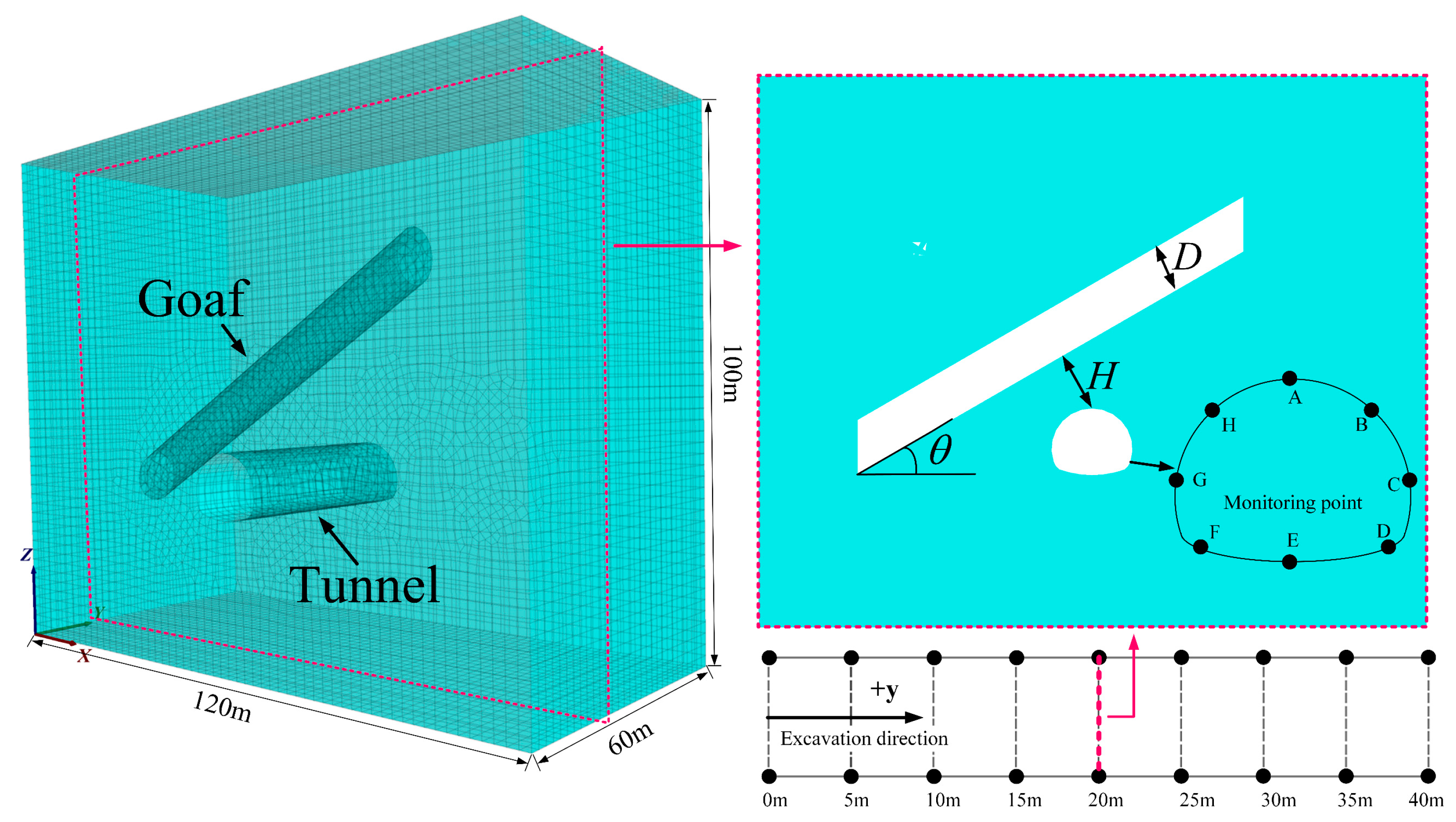
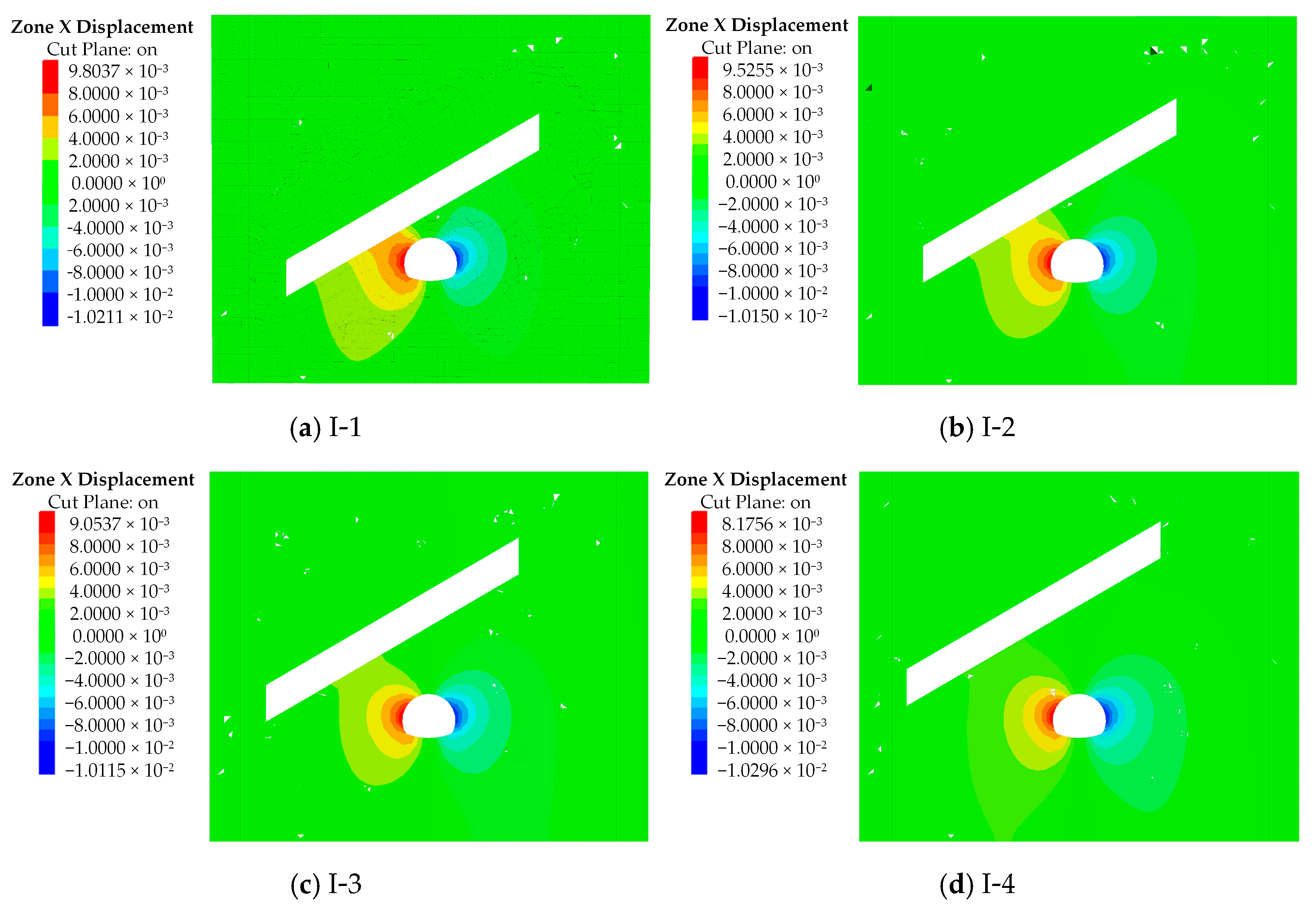
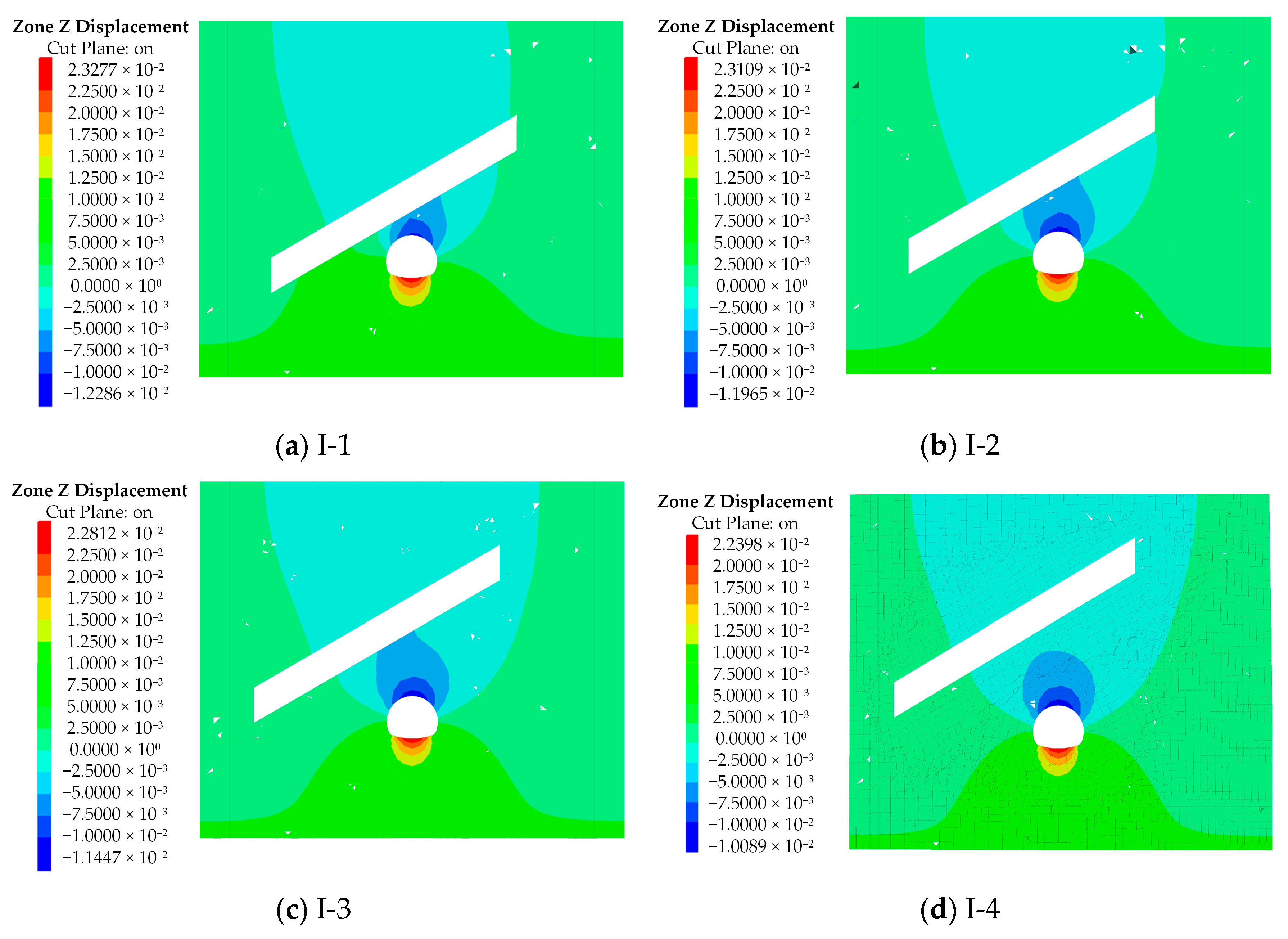
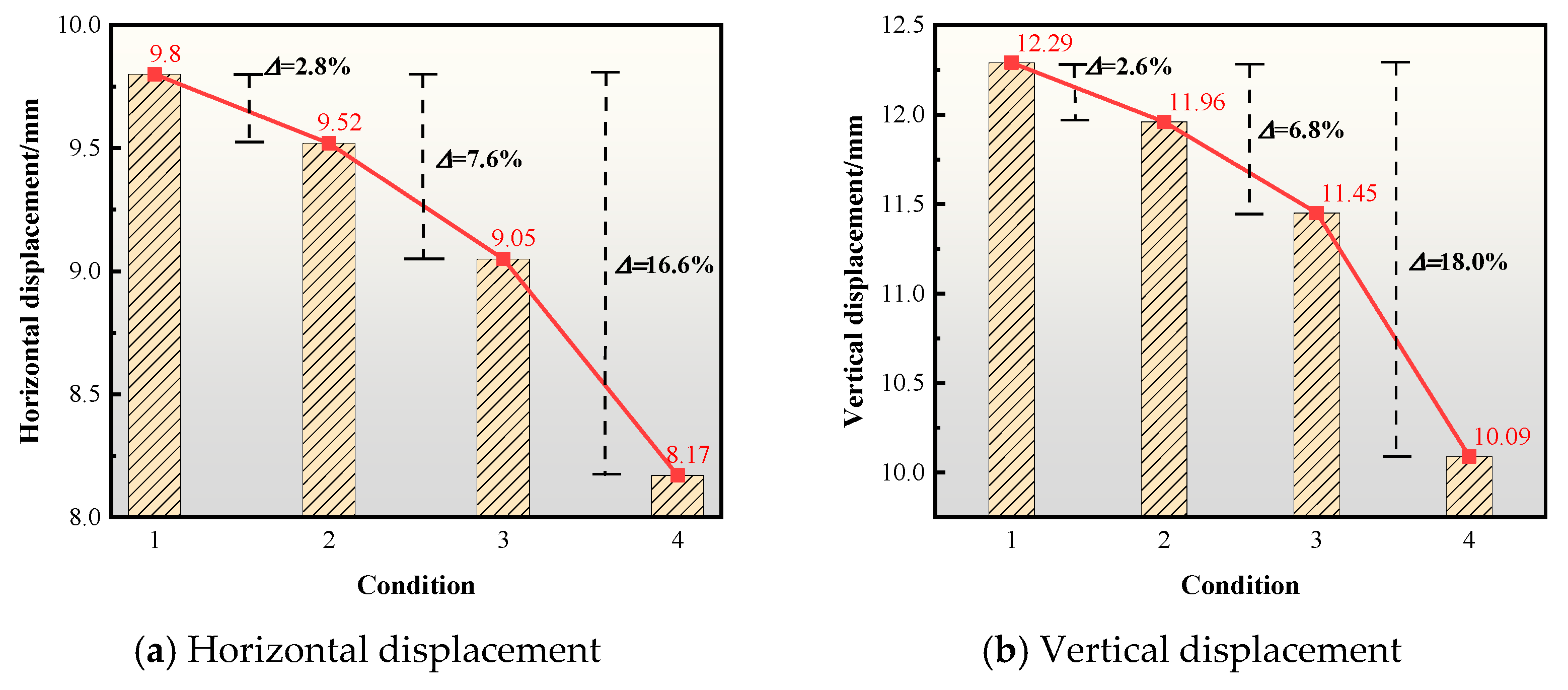
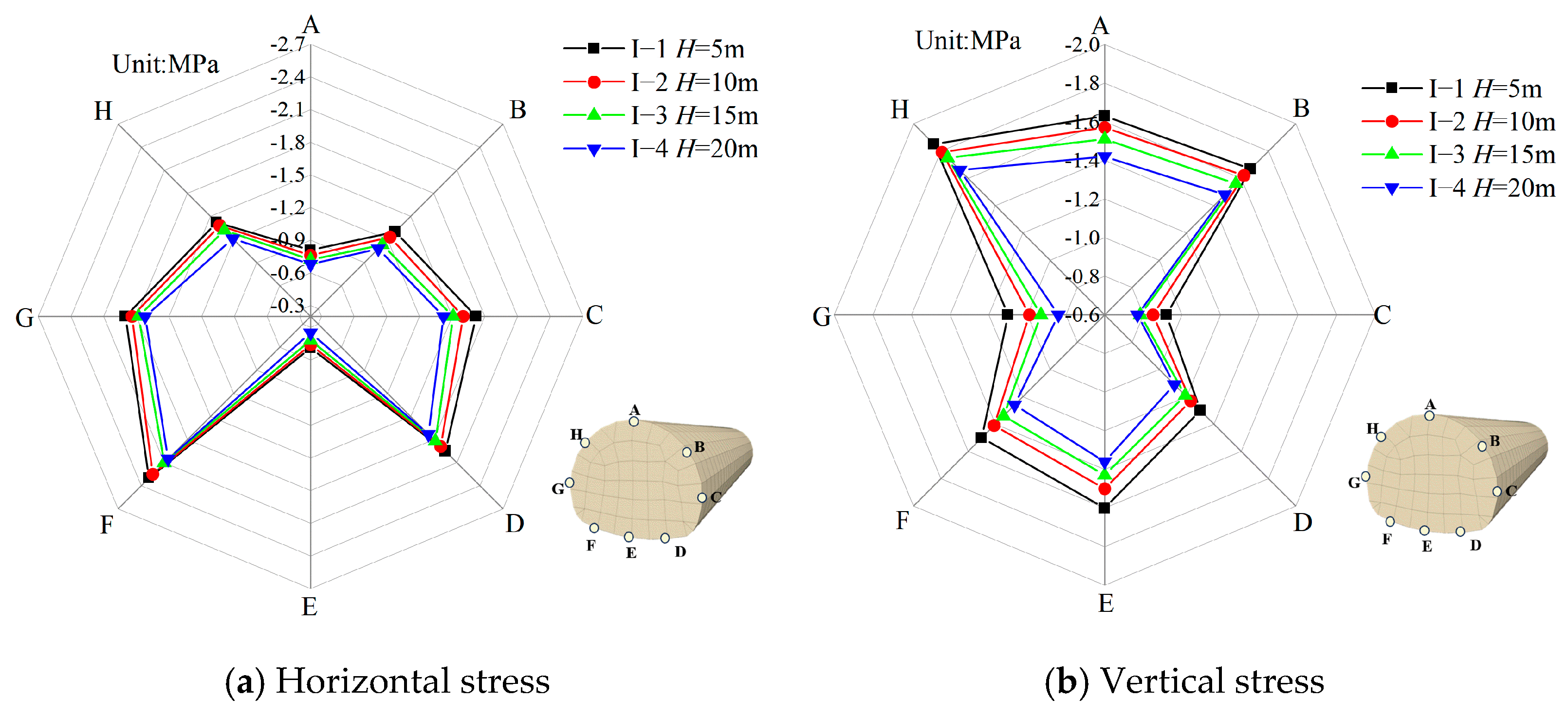
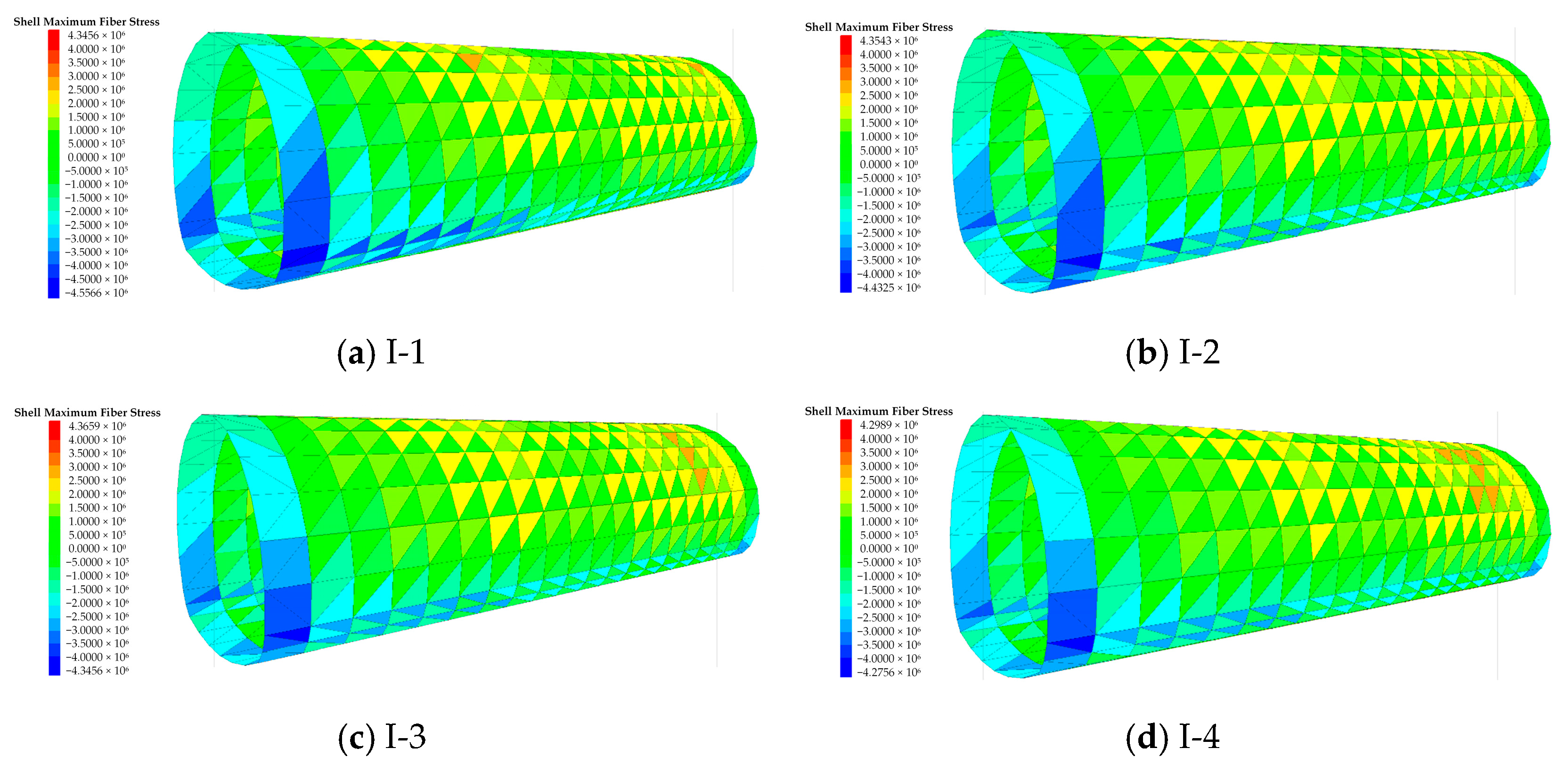
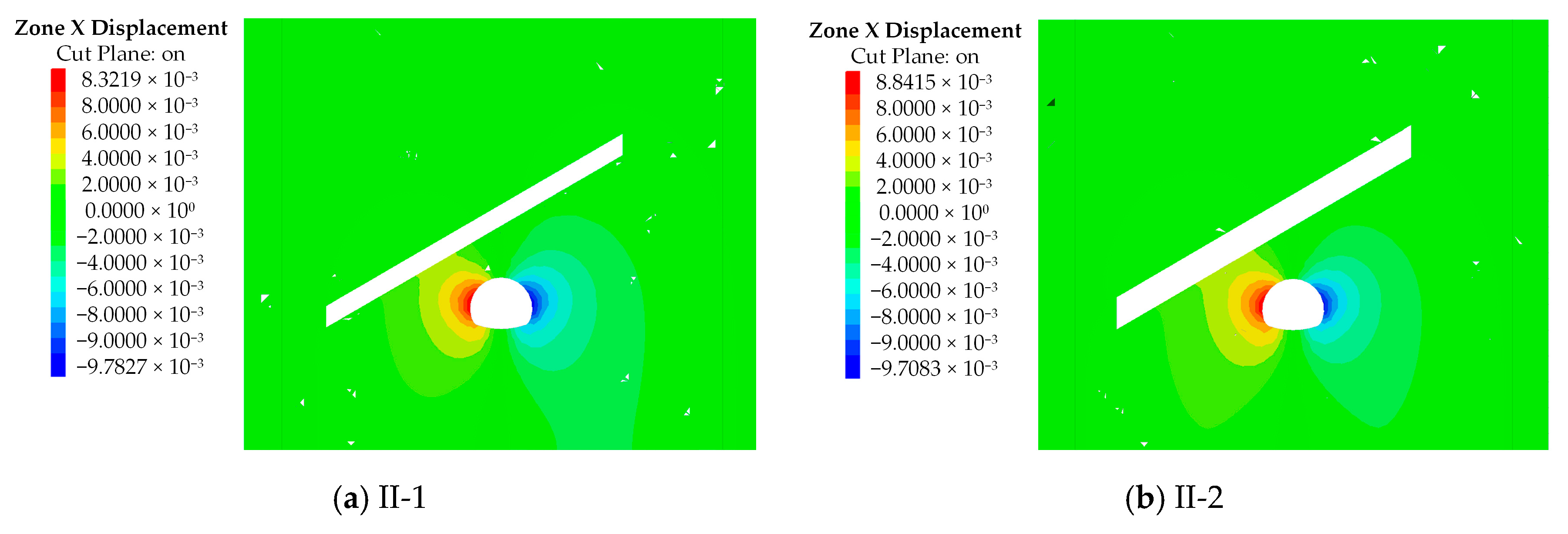


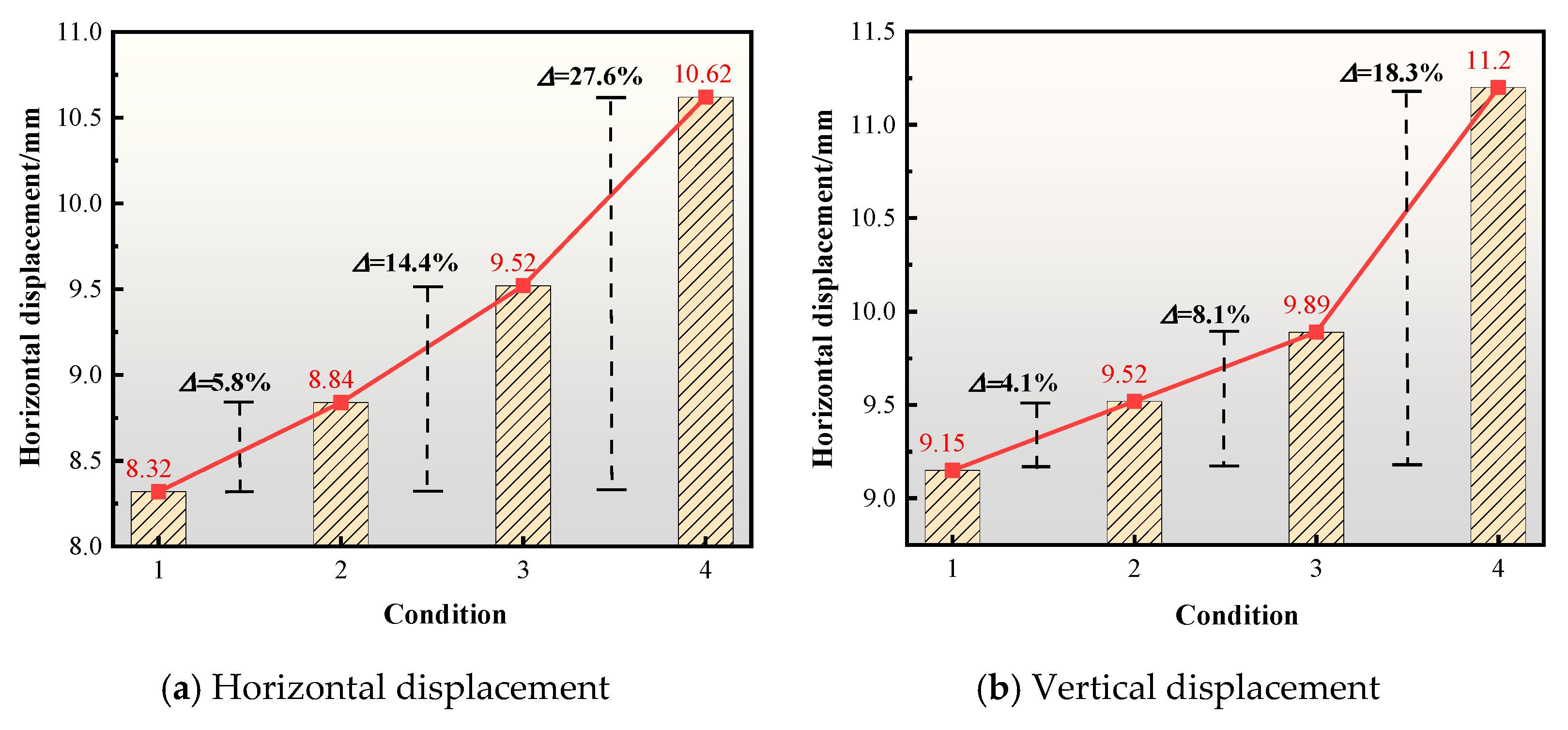
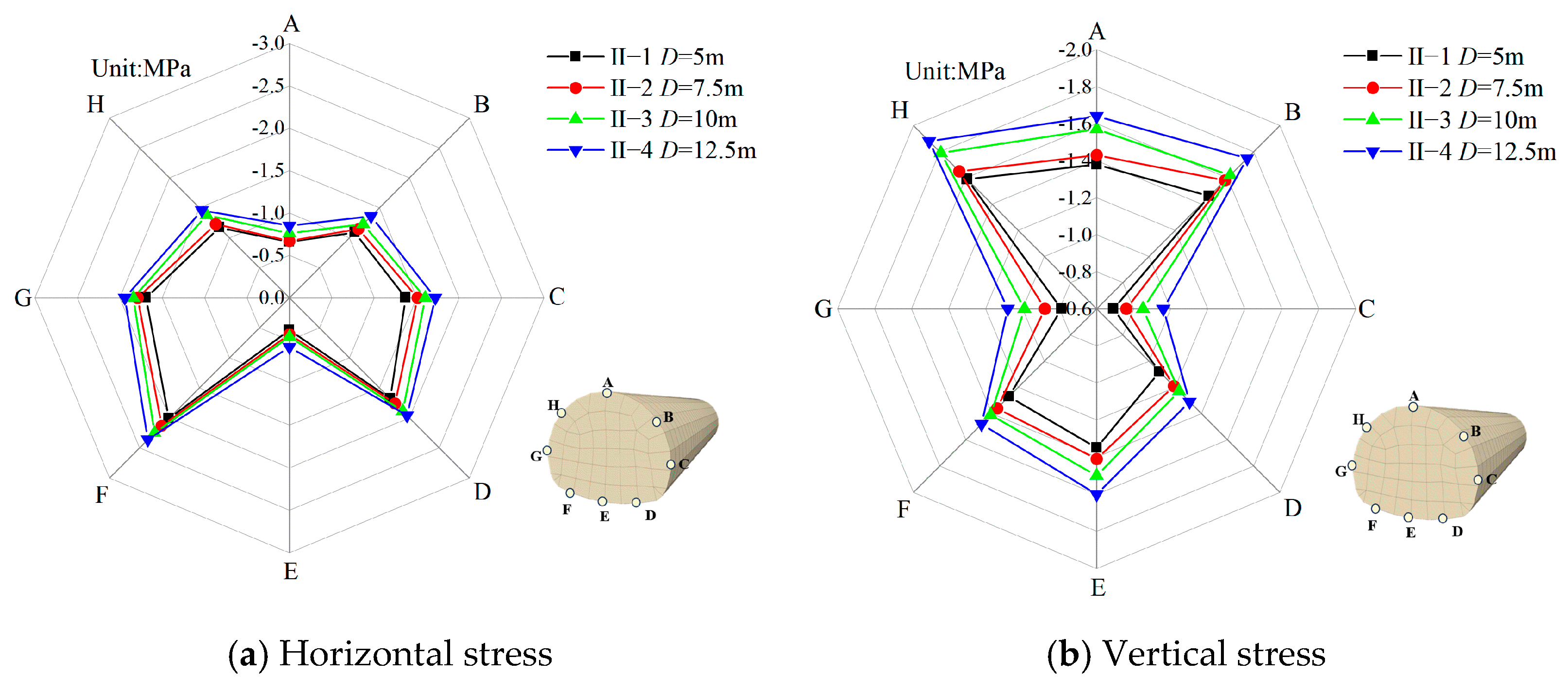
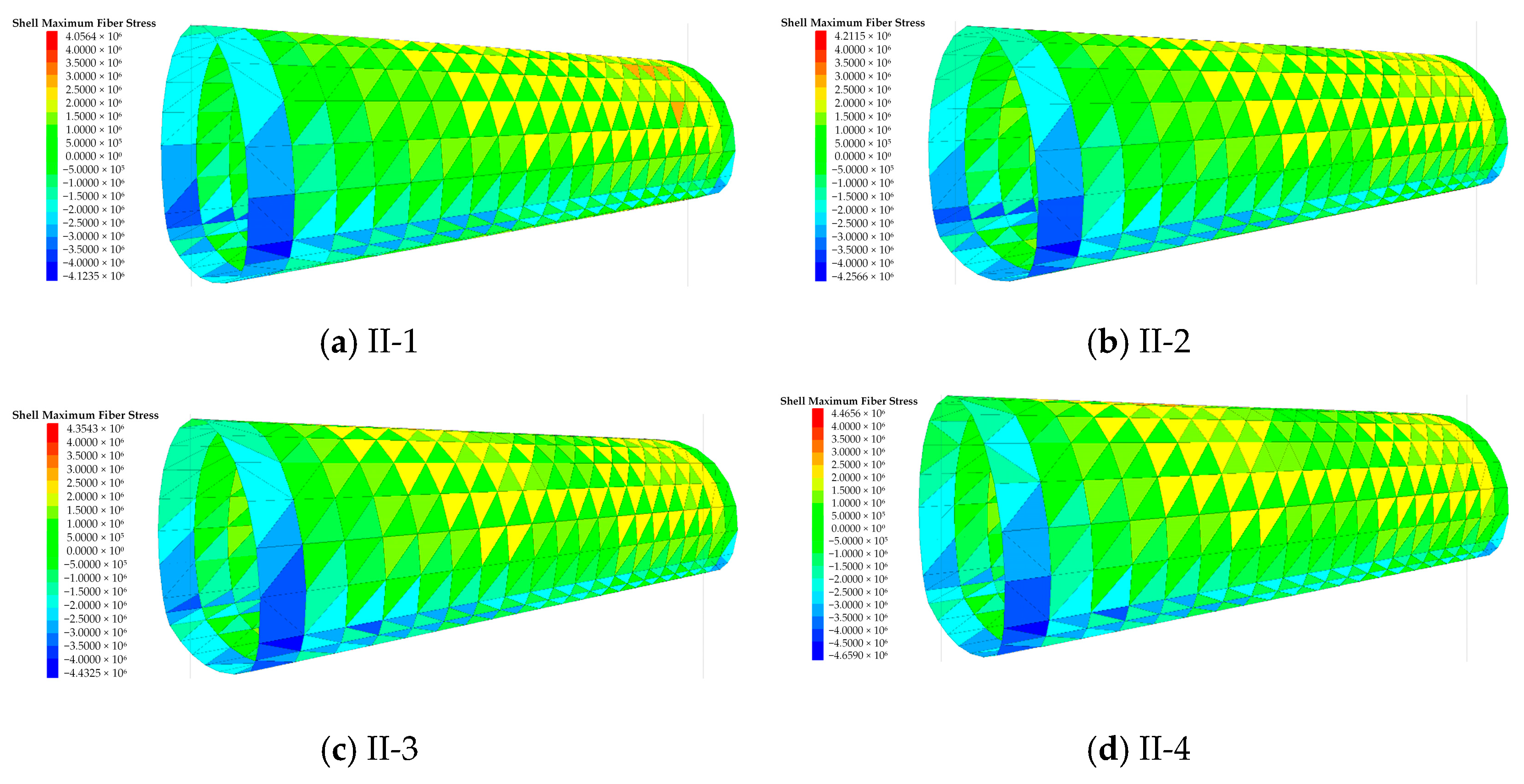
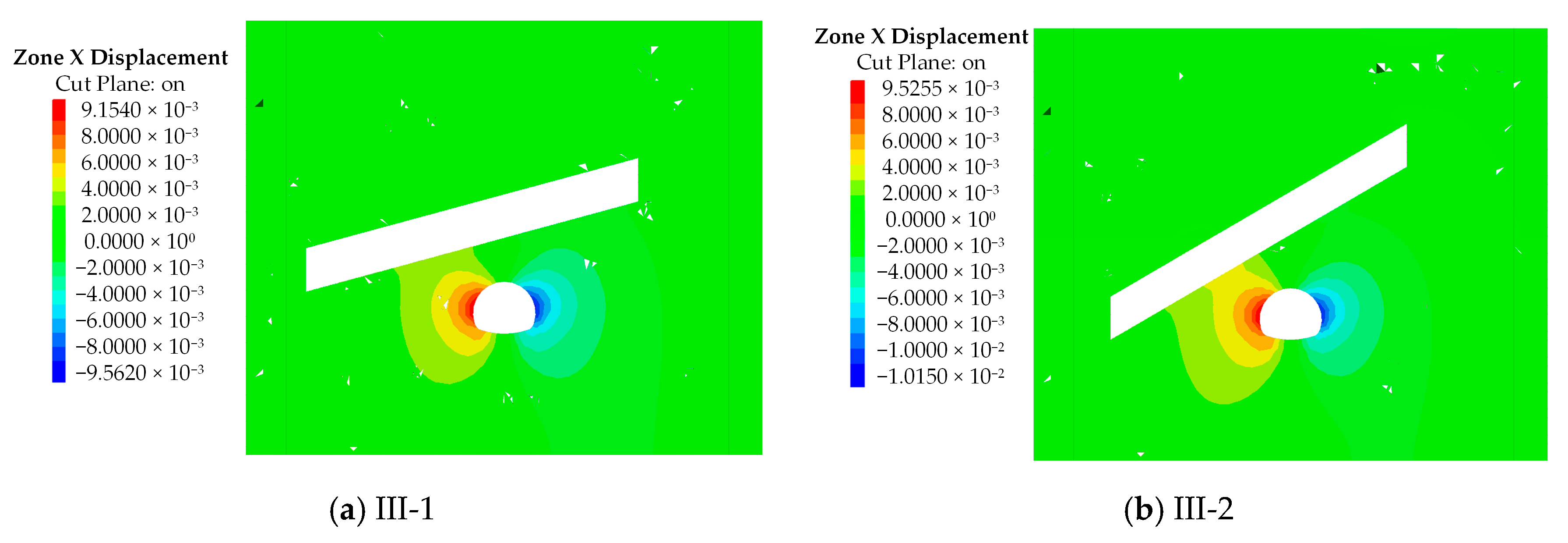
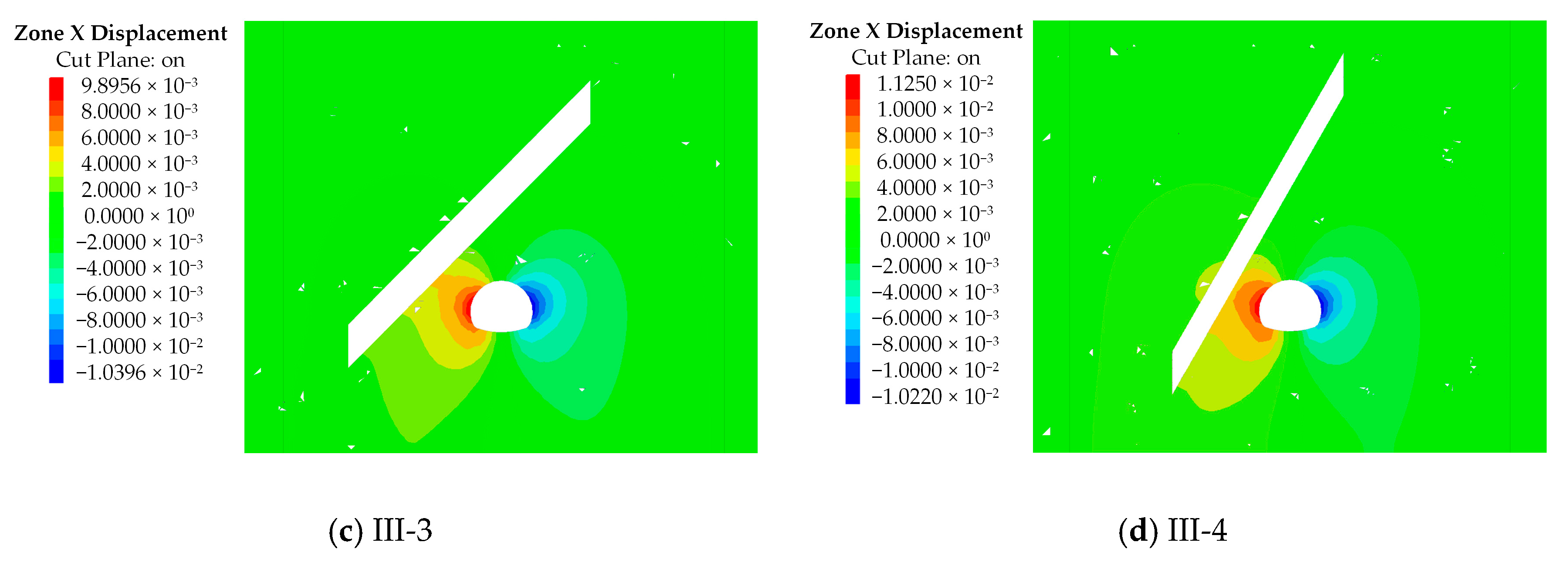

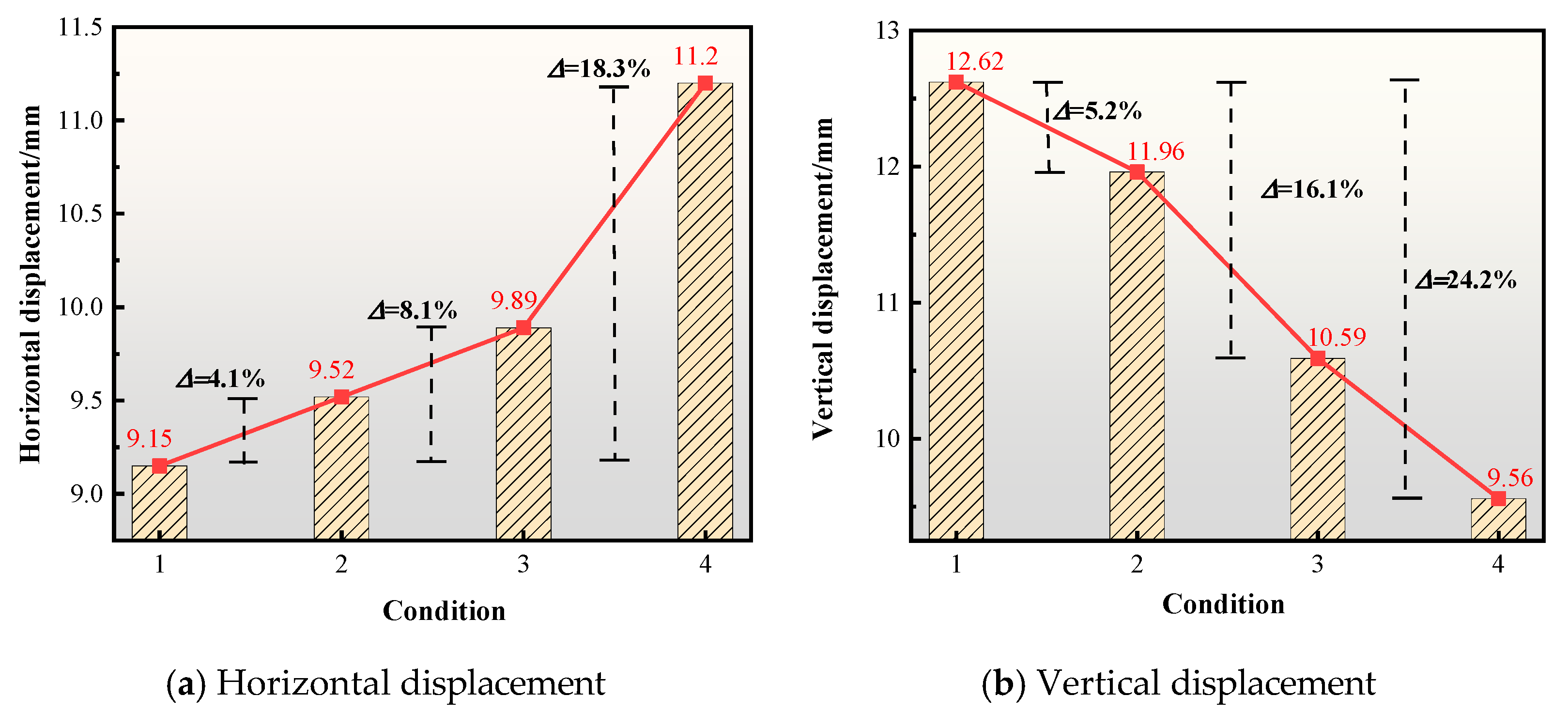

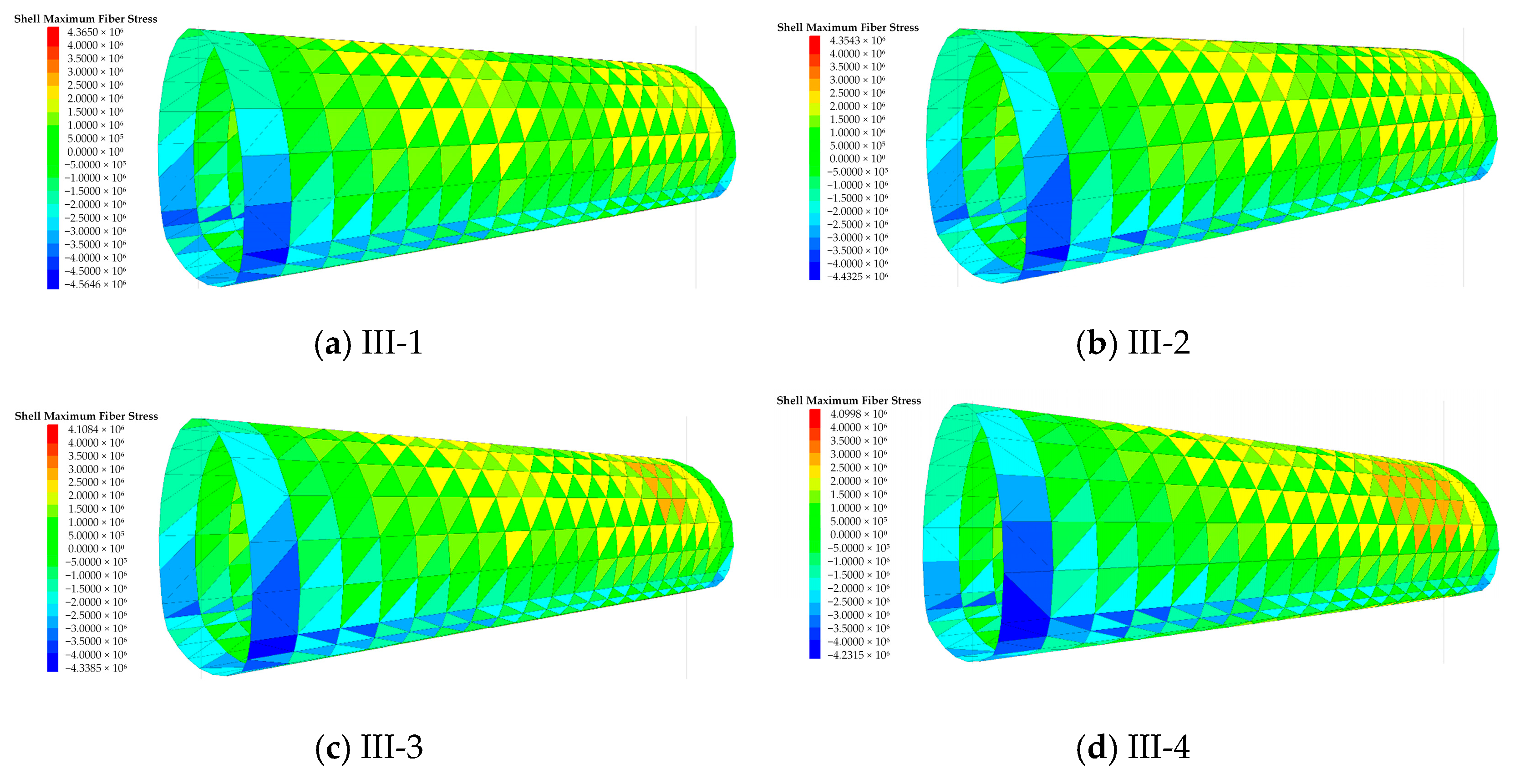
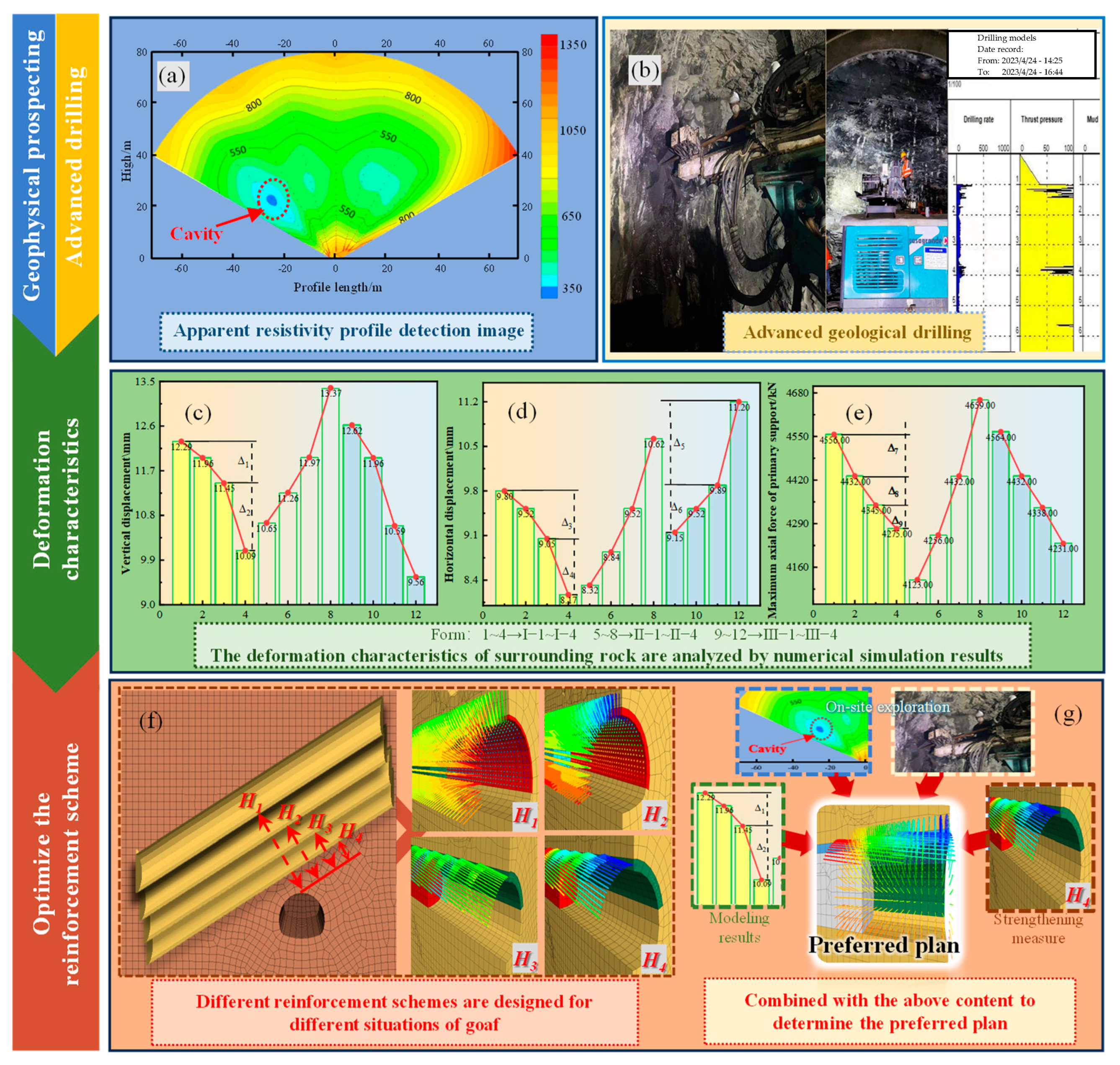
| Name | ρ/(kg·m−3) | E/GPa | μ | c/MPa | φ/(°) | K |
|---|---|---|---|---|---|---|
| IV Surrounding Rock | 2250 | 2 | 0.3 | 0.2 | 30 | 0.5 |
| Initial Support | 2500 | 25 | 0.22 | - | - |
| Goaf Situation | H/m | D/m | θ/° | |
|---|---|---|---|---|
| I: Different distance | I-1 | 5 | 10 | 30 |
| I-2 | 10 | 10 | 30 | |
| I-3 | 15 | 10 | 30 | |
| I-4 | 20 | 10 | 30 | |
| II: Different scale | II-1 | 10 | 5 | 30 |
| II-2 | 10 | 7.5 | 30 | |
| II-3 | 10 | 10 | 30 | |
| II-4 | 10 | 12.5 | 30 | |
| III: Different angle | III-1 | 10 | 10 | 15 |
| III-2 | 10 | 10 | 30 | |
| III-3 | 10 | 10 | 45 | |
| III-4 | 10 | 10 | 60 | |
Disclaimer/Publisher’s Note: The statements, opinions and data contained in all publications are solely those of the individual author(s) and contributor(s) and not of MDPI and/or the editor(s). MDPI and/or the editor(s) disclaim responsibility for any injury to people or property resulting from any ideas, methods, instructions or products referred to in the content. |
© 2024 by the authors. Licensee MDPI, Basel, Switzerland. This article is an open access article distributed under the terms and conditions of the Creative Commons Attribution (CC BY) license (https://creativecommons.org/licenses/by/4.0/).
Share and Cite
Zhao, M.; Guo, J.; Li, S.; Liang, S.; Sun, F. Stability Analysis of Surrounding Rock and Initial Support of Tunnel Undercrossing Multi-Situational Goafs: A Reference of Construction Guidance. Appl. Sci. 2024, 14, 7412. https://doi.org/10.3390/app14167412
Zhao M, Guo J, Li S, Liang S, Sun F. Stability Analysis of Surrounding Rock and Initial Support of Tunnel Undercrossing Multi-Situational Goafs: A Reference of Construction Guidance. Applied Sciences. 2024; 14(16):7412. https://doi.org/10.3390/app14167412
Chicago/Turabian StyleZhao, Meng, Jiaqi Guo, Shaohua Li, Shifan Liang, and Fengwei Sun. 2024. "Stability Analysis of Surrounding Rock and Initial Support of Tunnel Undercrossing Multi-Situational Goafs: A Reference of Construction Guidance" Applied Sciences 14, no. 16: 7412. https://doi.org/10.3390/app14167412





